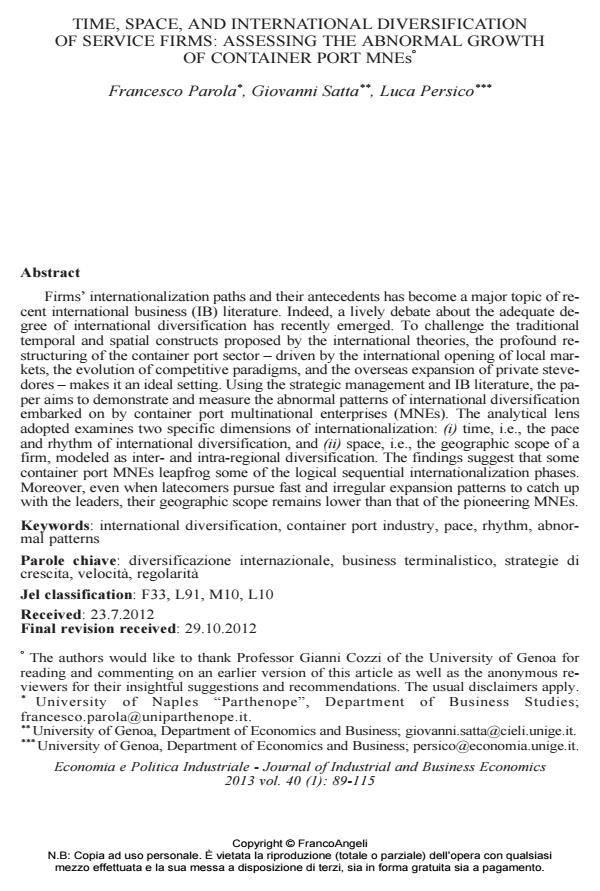Time, space, and international diversification of service firms: assessing the abnormal growth of container port MNs
Journal title ECONOMIA E POLITICA INDUSTRIALE
Author/s Francesco Parola, Giovanni Satta, Luca Persico
Publishing Year 2013 Issue 2013/1
Language Italian Pages 27 P. 90-115 File size 377 KB
DOI 10.3280/POLI2013-001004
DOI is like a bar code for intellectual property: to have more infomation
click here
Below, you can see the article first page
If you want to buy this article in PDF format, you can do it, following the instructions to buy download credits

FrancoAngeli is member of Publishers International Linking Association, Inc (PILA), a not-for-profit association which run the CrossRef service enabling links to and from online scholarly content.
Firms’ internationalization paths and their antecedents has become a major topic of recent international business (IB) literature. Indeed, a lively debate about the adequate degree of international diversification has recently emerged. To challenge the traditional temporal and spatial constructs proposed by the international theories, the profound restructuring of the container port sector - driven by the international opening of local markets, the evolution of competitive paradigms, and the overseas expansion of private stevedores - makes it an ideal setting. Using the strategic management and IB literature, the paper aims to demonstrate and measure the abnormal patterns of international diversification embarked on by container port multinational enterprises (MNEs). The analytical lens adopted examines two specific dimensions of internationalization: (i) time, i.e., the pace and rhythm of international diversification, and (ii) space, i.e., the geographic scope of a firm, modeled as inter- and intra-regional diversification. The findings suggest that some container port MNEs leapfrog some of the logical sequential internationalization phases. Moreover, even when latecomers pursue fast and irregular expansion patterns to catch up with the leaders, their geographic scope remains lower than that of the pioneering MNEs.
Keywords: International diversification, container port industry, pace, rhythm, abnormal patterns
Jel codes: F33, L91, M10, L10
- Corporate strategies and profitability of maritime logistics firms Francesco Parola, Giovanni Satta, Photis M Panayides, in Maritime Economics & Logistics /2015 pp.52
DOI: 10.1057/mel.2014.18 - L'impatto delle strategie corporate sulle performance delle imprese di logistica via mare Francesco Parola, Giovanni Satta, Riccardo Spinelli, in ECONOMIA E DIRITTO DEL TERZIARIO 2/2014 pp.201
DOI: 10.3280/ED2013-002002 - Entry mode choices of rapidly internationalizing terminal operators: Giovanni Satta, Luca Persico, in Maritime Economics & Logistics /2015 pp.97
DOI: 10.1057/mel.2014.32
Francesco Parola, Giovanni Satta, Luca Persico, Time, space, and international diversification of service firms: assessing the abnormal growth of container port MNs in "ECONOMIA E POLITICA INDUSTRIALE " 1/2013, pp 90-115, DOI: 10.3280/POLI2013-001004